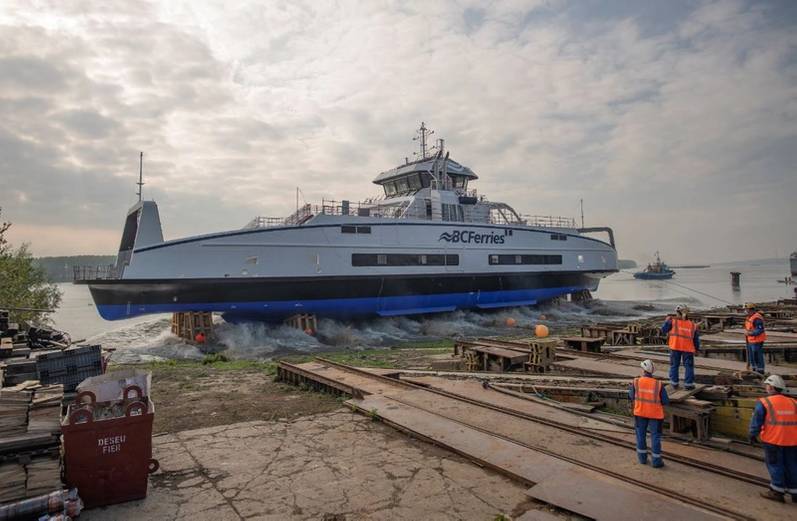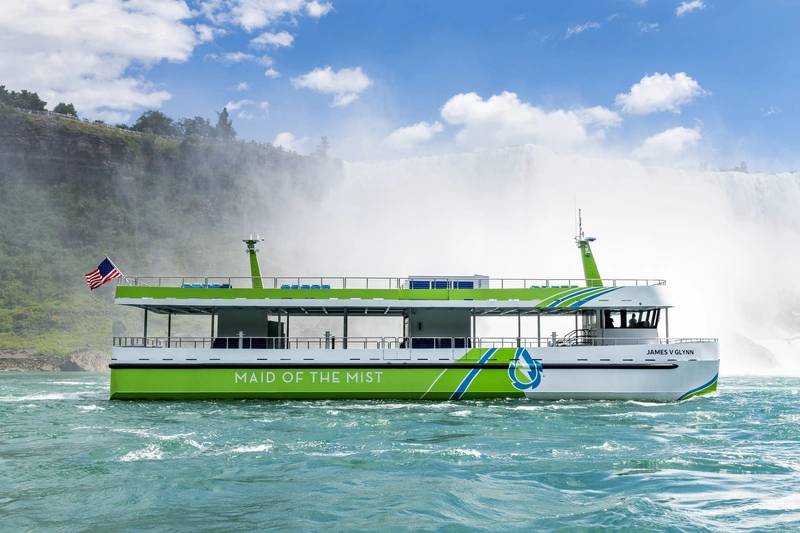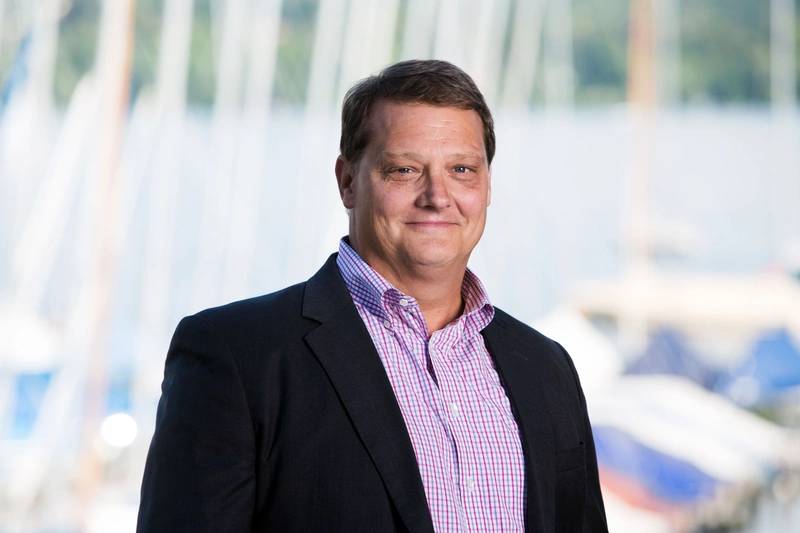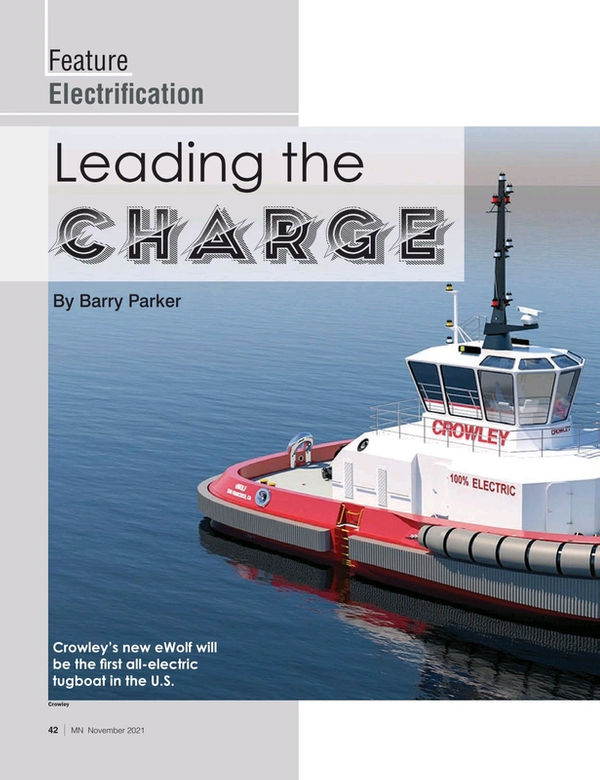
Leading the Charge
Alternatives to fossil fuels are emerging throughout the maritime universe, and vessels working in U.S. rivers, waterways and harbors are at the cusp on this trend. While the alternative fuels spectrum is wide, battery power and electrification—a technology that has seen a decade of shipboard applications already—is particularly suited for smaller vessels.
Crowley Maritime Corp will be taking delivery of a completely electric tugboat, dubbed eWolf; the boat- which will include kit for advanced vessel control tied to an electric propulsion system from ABB, is expected to be delivered in mid-2023 from Master Boat Builders in Coden, Ala., not far from Mobile. The boat will handle ship assists at the Port of San Diego, Calif. Crowley said, “The electric tug will replace one that consumes more than 30,000 gallons of diesel per year.” The 82-foot vessel will have 70 tons of bollard pull. Supplier ABB had noted, “It will be the first all-electric, battery-powered harbor tug ever built and operated in the United States and only the third of its kind to enter operations worldwide.” Crowley added that: “The eTug’s battery system will be charged at a specially designed, shoreside station developed with Cochran Marine.” Cochran, based in Seattle, is best known for its shore power hookups at East and West Coast ports. ABB said, “Batteries provide power to the propulsion system almost instantaneously.” The tug’s spec sheets indicate its 6.2- megawatt-hour (MWh) Corvus batteries will power a pair of Schottel azimuthing thrusters with two 2,100-kilowatt (kW) RAMME motors. ABB noted, “The battery allows the tug to complete a full day of typical work before there is a need to charge.” For long transits, a 9,800 gallon fuel reserve can power a pair of 300 kW auxiliary generators.
 Damen is building BC Ferries’ hybrid-electric Island Class vessels in Romania (Photo: Damen Shipyards Group)
Damen is building BC Ferries’ hybrid-electric Island Class vessels in Romania (Photo: Damen Shipyards Group)
Electrification is already being deployed in the North American ferry sector. Projects include BC Ferries’ Island Class hybrid boats built by Damen at its Galati yard in Romania, with the first two of six already in service. Reflecting the automobile industry’s influence on maritime efforts toward electrification, BC Ferries said, “The new Island Class is a diesel-electric battery hybrid ferry that has many similarities to a Toyota Prius car’s power train.” The passenger/car ferries’ electrically driven azimuth thrusters (from Schottel, 2 @ 950 kW, or 1,200 hp) are powered by diesel generators (2 @ 2,000 hp, or roughly 1,500 kW) with two Corvus battery packs of 400 kW each. Other ferries with hybrid capabilities on the drawing board include a boat architected by Elliott Bay Design Group (EBDG) that will be built for service in Casco Bay, Maine. Farther south, North Carolina’s state ferry system is also looking at electrification. And in the West, Skagit County Public Works and Seattle-based vessel designer Glosten are seeking proposals from electrical integrators to provide the vessel and shore electrical systems and the automated charging plug for a new all-electric ferry. A converted all-electric, zero-emissions car and passenger ferry has been operating in Gee’s Bend, Ala. since 2019.
For the short passenger excursion runs around Niagara Falls (typically 20 minutes), Maid of the Mist, a longtime operator of passenger tour boats, was able to go fully electric with a system put together by ABB. The boats, which entered service in late 2020, use 400 kW propulsion and 316 kWh of battery capacity (in two 158 kWh packs). A shore-based system provides re-charge capability during breaks for embarking/ disembarking passengers. In San Francisco, the dual powered sightseeing vessel Enhydra built by All American Marine has been in service since 2019, with a package designed by BAE Systems, using conventional propellers tied to the BAE HybriDrive propulsion system, with lengthy bona fides from the land transport sector. Kitsap Transit is also using a BAE electric-hybrid system for its passenger ferry Waterman, also built by AAM, which operates out of Washington State’s Port Orchard.
 Maid of the Mist’s James V. Glynn and Nikola Tesla are the first all-electric newbuild passenger vessels in the U.S. (Photo: ABB)
Maid of the Mist’s James V. Glynn and Nikola Tesla are the first all-electric newbuild passenger vessels in the U.S. (Photo: ABB)
Garrett Rice, the president of the Master Boat Builders yard, spoke to Marine News in detail about the eWolf order, while also providing insights on the likely future for fully electric tugs. “We have frequent conversations about ‘what’s next?’ because the technology and innovations are changing almost daily,” he said. “Boat operators are trying to see what should you invest in next…and want to invest in a boat that will last- for decades.” Among the 10 tugs presently under construction at MBB, he said that most are convention diesel powered, but there are two hybrids (diesel electric / diesel mechanical) and, now, the all-electric boat for Crowley.
There is not one boat type that will instantly become an industry standard. Rice offered the perspective that: “Every port in the United States is different…every job is different…and there are different missions for harbor tugs in each port. When you start bringing in different propulsion solutions besides conventional diesel, it does matter what the boat is going to be doing.” Summing up, he explained, “You can only put so many batteries into a harbor tug,” referring to constraints on the size of those vessels. “Harbor tugs are not very big,” he said. Looking ahead, Rice hinted at some news a few months out, saying, “We are working on a very flexible design- for a boat that can work in any harbor.”
The case for batteries for small boats serving harbors is a convincing one. Steve Trkla, president of the U.S. arm of Torqeedo, told Marine News, “One area that’s often overlooked when discussing electric vs conventional internal combustion systems is the superior instant torque delivered by electric drives at slow speeds. This translates into better maneuverability and more efficient pushing/pulling of loads.” His company, based near Munich, is a part of the DEUTZ Group, one of the world’s leading manufacturers of drive systems and offers a fully integrated high-voltage electric propulsion system Deep Blue and the Cruise product for smaller vessels. It also provides multiple battery options; its Deep Blue drive systems can be configured to provide lithium-ion battery bank capacity of between 80 kWh and 1 MWh.
 “One area that’s often overlooked when discussing electric vs conventional internal combustion systems is the superior instant torque delivered by electric drives at slow speeds.” - Steve Trkla, president of Torqeedo’s U.S. arm (Photo: Toreedo)
“One area that’s often overlooked when discussing electric vs conventional internal combustion systems is the superior instant torque delivered by electric drives at slow speeds.” - Steve Trkla, president of Torqeedo’s U.S. arm (Photo: Toreedo)
Much of the inspiration for U.S. designers and builders will come from Europe and Asia, with a head start on electrification for working boats, and also passenger ferries, serving the harbors and waterways. Rice, from MBB, mentioned BC Ferries’ project, and said, “Battery power makes a lot of sense, because the boats go from Point A to Point B, and then you can set your charging up.” Torqeeda’s Trkla cited electrification of vessels in Amsterdam, Paris and Istanbul, as well as Bangkok, which he noted is running a fleet of 20 Torqeedo-powered 40-passenger commuter vessels (including new vessels and retrofitted diesel units). In early October, Torqeedo announced that it had teamed up with Bremen-based boat-builder Fassmer, on a fully electric ferry concept, dubbed CIT-E, for passenger transport, particularly on urban waterways. The CIT-E boats, with capacity for as many 100 passengers, would be propelled by twin steerable thrusters, delivering continuous power of 100 kW (peak power of 130 kW), according to Fassmer.
Electric solutions will not be ubiquitous. A more cautious view on electric power came from Ted Tregurtha, the president of Moran Towing (involved in both harbor and coastal work), on a panel at the 2021 ShippingInsight conference, held virtually in mid-October 2021. On the subject of battery power, he told the online audience, “We are not there yet,” explaining that “from Moran’s perspective, packing a lot of energy into a very small package is difficult. We’ve not found commercially-ready technology for that.” He also expressed concerns about the present state of infrastructure, saying, “Even for something as simple as battery power, in most of the harbors in North America right now, you can’t get the amperage that you need in order to charge those batteries in a reasonable time frame.”
American Bureau of Shipping (ABS), in conjunction with a team from Vanderbilt University, published a report, “Decarbonization of the Inland Waterway Sector in the United States – Pathways and Challenges to a Zero-carbon Freight Future”. Though the study’s focus concerns vessels serving inland waterways (with Vanderbilt, situated in Nashville, having close ties with the local towboat owning community), a relevant finding is that the ubiquitous “fleet boats”, with wait times built into their daily work streams, are ideally suited for battery power. "The characteristics associated with Sustainability drivers of inland waterway fleet boats are similar for certain segments of the harbor tug market," said Roy Bleiberg, ABS vice president, North America regional business development.
With alternative energy still expensive, in many cases, compared to conventional fuels, the transition to electric (and other) power sources will not happen on its own. The ABS/ Vanderbilt report noted, “Decarbonizing the inland waterway sector will likely require new regulatory or market-based incentives, similar to those emerging in other economic sectors around the globe, in order to make decarbonization economically viable.” This is borne out in Crowley’s eWolf announcement, where they offer that “the eTug will be a result of a partnership among Crowley, the San Diego County Air Pollution Control District, the California Air Resources Board, the Port of San Diego, the U.S. Environmental Protection Agency and the U.S. Maritime Administration, which all provided financial support and other resources.”
 Skagit County Public Works and Glosten are seeking proposals to provide the vessel and shore electrical systems and the automated charging plug for a new all-electric ferry design. (Image: Glosten)
Skagit County Public Works and Glosten are seeking proposals to provide the vessel and shore electrical systems and the automated charging plug for a new all-electric ferry design. (Image: Glosten)
Electric boats are coming, but when?
Marine News queried Steve Trkla, president of Torqeedo’s operations in the States, on this question. He commented as follows: “The drivers behind the growth of marine electromobility worldwide are environmental and economical. The clock is ticking for the goals of the Paris Agreement. Transportation contributes about 25% of energy-related greenhouse gas emissions and is growing faster than any other end-use sector. Transitioning the light commercial fleet, such as passenger ferries, patrol boats, support vessels, freight transporters and offshore wind support vessels to electric power will make an enormous contribution to achieving those goals.”
On the economic considerations, he explained that the move toward electrified propulsion could be greatly accelerated if subsidies on fossil fuels are eliminated, a move supported by many signatories of the Paris Climate accord. “The current higher upfront costs for electric propulsion are more than offset by the savings in operating expenses, which yield lower overall costs of ownership,” he said, adding that, “We estimate that for a vessel that’s on the water more than 100 days a year, the operator can save money by going electric.”
When asked about particular projects with U.S. based operators in the works for Torqeedo, he could not comment on specific discussions, but wryly answered, “It would be interesting for us to revisit this subject again at the same time next year. I promise we’ll keep you and your readers informed as events unfold.”
 “We have frequent conversations about ‘what’s next?’ because the technology and innovations are changing almost daily.” – Garrett Rice, president, Master Boat Builders (Photo: Master Boat Builders)
“We have frequent conversations about ‘what’s next?’ because the technology and innovations are changing almost daily.” – Garrett Rice, president, Master Boat Builders (Photo: Master Boat Builders)
Electrically powered boats: what’s different? The shipyard view
From the shipyard perspective, what has to be done differently when building an electrically powered vessel working around harbors, compared to the conventional diesel version of a vessel performing similar duties? Marine News asked Master Boat Builders president Garrett Rice this question. “The hull form and the deckhouse are fairly the same. However, once you get into the actual propulsion system, it’s like night and day.” He explained further, “With a diesel boat, you need to think through the configuration of water-cooled engines, fuel piping, all the different pumps, and many other considerations.” For electric propulsion, “it’s totally different” he said, enumerating issues such as “wire weight, harmonics between power cables, separation of DC power cables from AC power cables, and the placement of numerous elements of smart systems that will avoid interference down the road.” He said, “Instead of doing extensive 3D modeling of the piping, we do less of that, but we do much more in the way of modeling the wire-ways.”
Rice stressed the importance of extreme cooperation among the multiple participants in the design and building process. Instead of dealing with competing aims of the shipowner, builder, and naval architects, which could potentially arise, he said, “We developed an approach where we could bring all the parties to the table early on, at the beginning of the design process, to make sure that all perspectives are heard and are on the table and carefully looked at.”
Read Leading the Charge in Pdf, Flash or Html5 edition of November 2021 Marine News
Other stories from November 2021 issue
Content
- Interview: Will Roberts, President, Foss Maritime page: 14
- Feds Struggle to Address Supply Chain Capacity Issues page: 20
- Maritime for the Win(d) page: 23
- Maritime Cybersecurity: Prepare, Detect and Respond page: 30
- Inland Waterways: A Crucible of Issues page: 34
- Leading the Charge page: 42
- Marine News' Top Boats of 2021 page: 50


